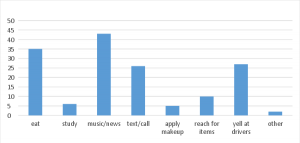Dear Mount Observer,
Please stop promoting pit bull type-dogs as safe pets. Families need the correct information to make an informed decision when choosing a safe pet. Keep pumping pit bull type-dogs to unsuspecting families and the death toll will continue to rise. Anyone that markets this type as a safe family pet without sharing the statistics is misinforming the public.
Common Sense: Pit bulls are selectively bred to recognize other dogs as prey to fight in a pit to the death. You never know when it will be triggered. Simple noises and movement can trigger the pit bull’s prey drive into a deadly attack. This is not a safe breed trait to have in a family pet.
Dr. Michael S. Golinko, who completed the largest dog bite study to date, states pit bulls are a danger to children: http://nationalpitbullvictimawareness.org/expert-opinions/
This NEW WARNING from Pediatricians about pit bull type-dogs should be shared with all families so they can make an informed decision: “A University of Arkansas for Medical Science’s largest dog bite study to date at a Georgia hospital in July 2016 came to this conclusion: “The study corroborates the largely negative interactions between pit bulls and children of any age.”
From the abstract: “Pit bull bites were implicated in half of all surgeries performed and over 2.5 times as likely to bite in multiple anatomic locations as compared to other breeds.” https://www.researchgate.net/publication/305270428_Characteristics_of_1616_Consecutive_Dog_Bite_Injuries_at_a_Single_Institution
11 PEER-REVIEWED Medical Studies that prove pit bull type-dogs are not safe family pets: Level 1 trauma center dog bite studies from all geographical regions in the U.S. are reporting a higher prevalence of pit bull type dogs injuries than all other breeds of dogs. In many cases, the studies (2009 to 2016) also report that pit bull injuries have a higher severity of injury and require a greater number of operative interventions. http://blog.dogsbite.org/2016/10/table-retrospective-level-1-trauma-dog-bite-studies-2009-2016.html
A documentary produced by CBC’s Fifth Estate investigative team (September 22, 2017) is the first television program to examine the multi-million-dollar US lobbying effort to rebrand the pit bull as a family-friendly dog. Please watch this NEW 44 minute investigation that presents both sides of the argument. It proves shelter and rescue systems are asking families to play Russian Roulette with their children. PLEASE WATCH: http://www.cbc.ca/player/play/1053062723713
Most dog breeds don’t have the genetic makeup to execute a dog bite level 4-6.
Most dog breeds bite and release. Pit bulls bite and do not let go until their victims are dead. This is part of their genetic code called their ‘gameness’ trait.
“The dog is extremely dangerous and mutilates. The dog is simply not safe around people. I recommend euthanasia because the quality of life is so poor for dogs that have to live out their lives in solitary confinement.” This dog bite level 1-6 chart is a helpful tool for the danger level of the dog. http://apdt.com/wp-content/uploads/2017/01/ian-dunbar-dog-bite-scale.pdf
Pit-bulls are dangerous because they have the capability of inflicting life-threatening injuries in a split second. Pit bulls are zero-mistake dogs.
All dog breeds are human-made creations, the result of unnatural selection to achieve desired traits/ characteristics for certain tasks. They’re individuals, yes, but you should always expect for them to display those characteristics. Pit bulls have been bred for violent blood sports with a deadly bite. They are not safe or appropriate pets and should never be considered as such.
Pit bull advocates make the false assertion ‘it’s how they are raised’ without actually following dangerous dog attacks.
I was misled for many years about the many myths about pit bull type-dogs making safe family pets and it’s all how you raise pit bulls.
I come from the animal rescue community. I have fostered many animals and a few pit bull type-dogs found as strays. All my pets have been rescued. I can’t in good conscience recommend any dog that resembles a pit bull type-dog to a family as a safe family pet because of unethical breeding practices, dangerous breed traits and genetics.
Families absolutely should not adopt a dog that resembles a pit bull type-dog with an unknown breeding history and with unknowns about how the dog was raised. Shelter and rescue systems are asking people to play Russian Roulette with their pet choices.
I have been following dangerous dog attacks for four years. I’m in a support group with some of these families. All these families were blind-sided by a horrific pit bull attack. All these pit bulls were house dogs and considered members of the family. None of these dogs were trained to fight. Pit type dogs are hardwired to maul and kill without warning, it is a part of the genetic code like border collies herd, labs swim, goldens retrieve, pointers point, and bloodhounds track.
Correct there are nice pit bulls. The problem is that you can’t tell them apart from the pit bulls that decide to kill. Would you deliberately choose a crib, car, or helmet with the highest record of fatalities and the worst safety rating? Pit-bull type dogs are responsible for 95% of severe attacks (level bite 4-6) on people, pets and livestock in breed neutral zones. Please follow for one month. You will be shocked at all the people and pets that are severely maimed or killed by pit bulls.
National Pit Bull Victim Awareness
Please spend some time witnessing to the victims of pit bull attacks. Most attacking pit bulls are not due to bad owners but naïve owners who do not understand the dangerous pit bull breed traits. From 2005-2018, 281 people killed by pit bull type dogs. http://www.dogsbite.org/dog-bite-statistics-fatalities.php
Here is an incident list of shelters who re-homed pit bulls that attacked: http://safetybeforebulldogs.blogspot.com/2014/05/list-of-pit-bulls-recently-adopted-from.html?m=1
Two words to prove pit bull type dogs are inherently dangerous: “BREAK STICK”.
Does this sound like a normal and safe dog breed to have live in our neighborhoods? Pit Bull Rescue Central recommends ALL pit bull owners to have a “break stick”, a wedge-shaped piece of wood used to pry open a pit bull’s jaw during an attack. “Since pit bulls have a strong fighting background, we recommend that pet owners also have a breaking stick as a precaution.” http://blog.dogsbite.org/2008/09/break-sticks-tool-used-to-pry-open-pit.html
This person demonstrates how to use a break stick on a pit-bull: https://www.youtube.com/watch?v=KfMVH4wY5Pg
Pit bull type dogs kill an estimated 30,000 animals a year.
Record 32,550 pit bulls killed or badly injured other animals in the U.S. in 2016
Pit Bull Rescue Central, the leading authority on pit bull-type dogs, admits most pit bull-types are not safe around other people’s dogs because of their genetics. Pit Bull Rescue Central states, “Pit bulls were bred to recognize other dogs as “prey”. http://www.pbrc.net/breakfight.html For that reason alone, I do not consider them safe family pets for our neighborhoods. These are powerful animals that break away from their guardians all the time and maul and kill another beloved pet or person, often in front of a child or pet owner.
This is a typical pit attack on another beloved pet: https://www.youtube.com/watch?v=9ZTiGWgQubA Too many children & adults have watched their beloved pets be mauled to death by pit bulls. Many develop Post-Traumatic Stress Disorder after watching a horrific pit attack: http://www.liveleak.com/view?i=684_1405912995
According to Pit Bull Rescue Central, “It is a FACT that our pit bulls, AmStaffs and pit mixes come with a built-in fighting heritage. It doesn’t matter where we get them from, whether it be the pound, a stray we pick up, or a puppy we buy from a breeder. The majority of pit bulls will, at some point in their lives, exhibit some degree of dog-on-dog aggression. Yet, chances are that a “normal” pit bull will not share his affection with other animals. We cannot predict when or where it will happen and we can’t love, train or socialize it out of the dog. Pit bulls may not start fights, but they will finish them.” http://www.pbrc.net/misc/PBRC_dogpark.pdf”
Red Flag: MOST insurance companies have come to the same conclusion and do no cover pit-bulls because they can’t afford the risk. Insurance companies have a calculated actuarial risk of pit bulls a lot higher compared with other dog breeds. Pit bulls are more likely to attack their owners. Dog attacks are the third most common claim on homeowner’s insurance. More evidence that people who have pit-bulls and certain other types of breeds are endangering people and other people’s beloved pets in our communities. https://www.esurance.com/info/homeowners/does-homeowners-insurance-cover-pit-bulls
Dogs can be great escape artists. When pit bulls get loose it can be dangerous and deadly for everyone in the neighborhood. Child Killed in Pit Bull Attack On Way To School. Two other children were injured: a little girl face was totally dismembered and the other child was evaluated and released. Breed Choice Matters for keeping our communities safe. http://blog.dogsbite.org/2017/01/dog-bite-fatality-pit-bulls-kill-child-atlanta.html
Why should public safety depend on how someone raises their dog? There are irresponsible owners of poodles, beagles, greyhounds and I could name 300 dog breeds that will not lead to severely maimed or dead neighbors, pets and children. It shouldn’t be a death sentence for any of us to depend on all pit owners to raise their pit right. That’s impossible. If you think it’s how they are raised, then they should be regulated or banned.
An estimated 292 U.S. military bases ban pit bulls. There are 1,052 U.S. cities and 43 countries which enact breed specific ordinances because pit bull type-dogs present an unreasonable risk to health and public safety. https://www.scribd.com/doc/56495216/Estimated-U-S-Cities-Counties-States-and-Military-Facilities-with-Breed-Specific-Pit-Bull-Laws
PIT BULL EXPERTS:
Tia Torres, who has a T.V. show on Animal Planet called “Pit Bulls & Parolees”, wrote this for Rescue Train. “It’s a mistake to think the fighting gene can be easily trained or loved out of a pit-bull.” http://www.therescuetrain.org/pit_bull_education.php
Pit Bull Federation of South Africa – PBFSA’: “Pit bulls were never designed to be 100% safe with other animals.” https://www.facebook.com/permalink.php?story_fbid=2134509080109275&id=1622413151318873
Why they think it’s appropriate to rehome pit bulls after saying that is beyond me. Owning and adopting out predators of other people’s beloved pets compromises public safety. In my opinion it’s immoral.
Please read ‘HOW TO PREVENT YOUR PIT BULL FROM FIGHTING’. Bully Max is more honest than most shelters and rescues staff/volunteers who deny pit bull breed traits. They admit pit bulls are bred for fighting. It’s best to own only one pit bull. NEVER bring an adult pit bull to an off-leash dog park We need to start being more honest about pit bull breed traits or we are setting people and dogs up for failure. https://bullymax.com/preventing-pitbull-fights/
A Propensity to Attack Other Dogs Means a Dog Is Dangerous to People. Approximately one-third of Mr. Phillips’ cases started out as a dog attacking another dog, and then turned into a dog attacking a person. https://dogbitelaw.com/vicious-dogs/a-propensity-to-attack-other-dogs-means-a-dog-is-dangerous-to-people
BENJAMIN HART, professor emeritus at the UC Davis School of Veterinary Medicine and animal behaviorist says, “It’s quite common for a pit bull to show no signs of aggression. People will call it a nice dog, a sweet dog, even the neighbors – and then all of a sudden something triggers the dog, and it attacks a human in a characteristic way of biting and hanging on until a lot of damage is done. Hart said pit bulls are responsible for about 60 percent of dog attack fatalities each year, which is “way out of proportion” compared with other breeds. Pit bulls make up less than 5 percent of the American dog population. “It’s very poor policy to allow any child around a pit bull, in my mind, let alone climb on a dog.” More info from pit bull experts: http://thetruthaboutpitbulls.blogspot.com/2012/10/no-one-can-be-great-thinker-who-does.html?m=
Most dogs warn you before they attack, growling or barking to tell you how angry they are—”so they don’t have to fight,” ASPCA adviser and animal geneticist Stephen Zawistowski stresses. Not the pit bull, which attacks without warning. Most dogs, too, will bow to signal that they want to frolic. Again, not the pit bull, which may follow an apparently playful bow with a lethal assault.” More information from experts about pit bull traits: http://www.city-journal.org/html/9_2_scared_of_pit.html
Words from Ronald Berman professional dog bite expert in court cases and dog trainer: “Pit bulls are the number-one breed for fatalities.I see photos of people with their faces ripped off. I look at autopsy photos and afterward I can’t sleep at night. What sets the pit bull apart is its gameness—the willingness to attack and keep attacking. The more you hurt them, the more relentlessly they attack. In one case, a bystander hit a pit bull more than 20 times with a metal baseball bat, and the dog wouldn’t stop attacking the victim.” https://www.runnersworld.com/runners-stories/when-dogs-attack
I forwarded a picture of a pit bull mauling on a little boy’s arm. https://www.msn.com/en-us/news/crime/child-hospitalized-after-being-attacked-by-neighbors-pit-bull/ar-BBHqflC I agree all dogs can bite. The issue with pit bulls is the degree of damage they inflict, and their attacks being more likely to result in fatality. Appellate courts across the United States have recognized the dangers of the pit bull breed for over 25-years. We’ve listed excerpts from court decisions that demonstrate this. http://www.dogsbite.org/legislating-dangerous-dogs-appellate-court-decisions.php
I forwarded four photos of children who, through no fault of their own, were attacked by pit bulls. The parents have deep regret ever allowing their children around pit bulls that they considered safe. These are just a few examples out of thousands.
1) Boy’s face is DESTROYED by adopted pit-bull http://blog.dogsbite.org/2017/03/newly-adopted-pit-bull-mix-attacks-boys-face-in-iowa.html
2) Little girl’s face destroyed by the neighbor’s pit bull! Video of pit bull: http://www.nwfdailynews.com/news/20170329/child-mother-mauled-by-pit-bull-photos and https://www.gofundme.com/evj94r-help-for-Zoey
3) Maybe you have a safe pit bull but how if your neighbor does not? Little girl almost killed by the neighbor’s pit bull. Besides being scalped by the neighbor’s pit bull in her own yard, she has lost both ears, an eye, and will never grow hair. http://www.abc57.com/news/fundraising-page-set-up-for-girl-brutally-attacked-by-pit-bull
4) After reading this, will you allow your kids to sleepover with another family’s pit bull? Friend’s pit bull attacked him while sleeping. “They did a CT scan and said the bite was so bad that it was a hair away from crushing his skull and killing him.” http://www.nwitimes.com/news/local/crime-and-courts/gofundme-launched-for-hobart-boy-mauled-by-dog/article_220bafca-d5f6-58a7-8051-080b6d357029.html
Thanks for listening to my concerns,
Julie Wall
Supporter of National Pit Bull Victim Awareness
Dogsbite.org
Daxtonsfriends.com
-Julie ( julie.eyrich@gmail.com )








